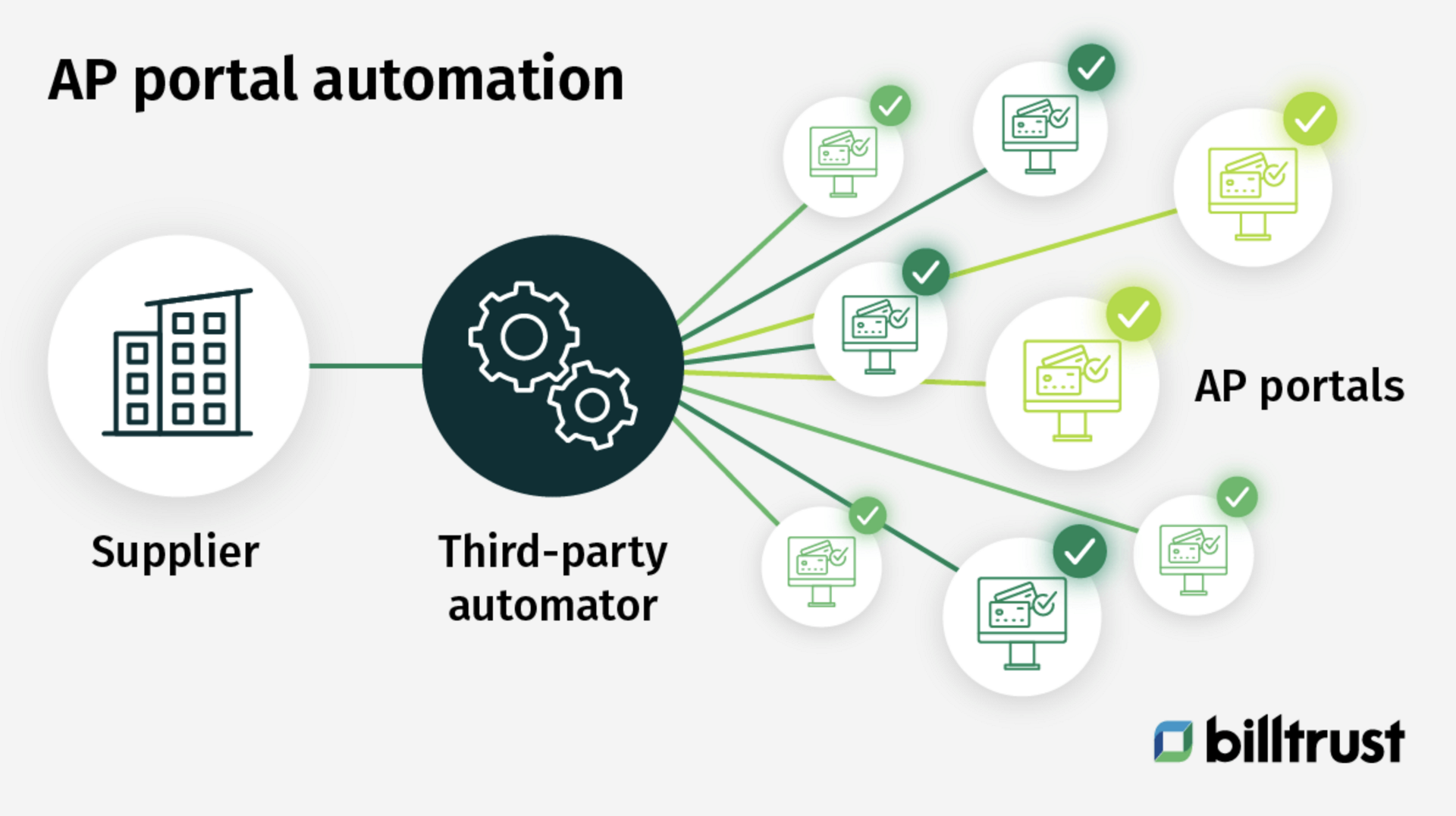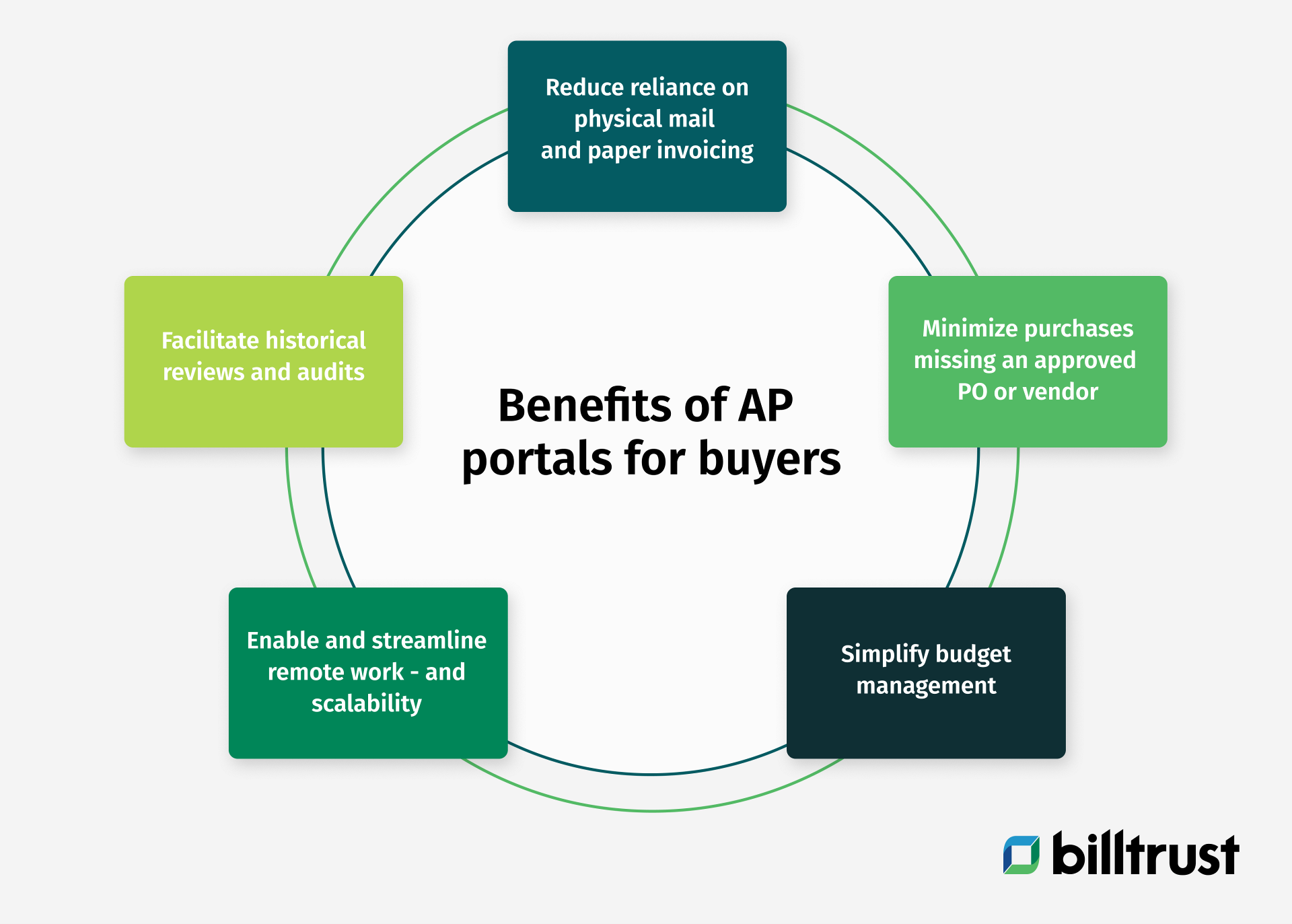Why are B2B AP portals on the rise?
Blog | September 12, 2022
Reading time: 6 minLearn what's driving more buyers to mandate sellers use these portals.
Learn what's driving more buyers to mandate sellers use these portals.
From the point of view of some B2B sellers, digital accounts payable (AP) portals may seem like another new hurdle to overcome in their never-ending pursuit of getting invoices paid.
AP portals, or procure-to-pay portals, are implemented by the accounts payable departments of many large businesses to automate the acceptance and processing of invoices. For vendors and suppliers, these portals have added an unwelcome level of complexity and labor to the B2B payments process.
As Billtrust’s Amanda Wilson explained in a recent blog post, “I have numerous customers trapped in a cycle of managing 20, 30 or even 50 different AP portal requirements.”
Each of those portals has its requirements and protocols, resulting in a huge amount of keystroking and manual management to submit and track the status of invoices. That is, for accounts receivable (AR) teams stuck in traditional processes, more on that later.

We asked Elizabeth Gerould, Controller, Financial Operations, Billtrust, how to address this paradox. Can vendors and suppliers cope with AP portal fatigue and keep pace with new AP platforms?
As she explained, it’s essential to see the situation from the buyer’s POV. If they’re a sizable company dealing with thousands of monthly payables, AP portals are increasingly necessary to business success.
According to research by PYMNTS.com:
97% of firms said if they could not handle AP volume, it would hinder their goals for revenue growth, with 31% saying these goals would be very or extremely inhibited.
PYMNTS.cOM
Another driving factor? The increasing number of government mandates for vendors and suppliers to use e-invoicing. It’s already mandatory in many European countries, and an AP portal provides the buyer with a single central intake point for those invoices. The USA is also investigating establishing a national standard for B2G e-invoicing.

Elizabeth shared a list of the benefits that are motivating organizations to deploy AP portals:
It’s called “snail mail” for a reason, and for buyers that still put up with letting vendors and suppliers use standard postal delivery, it’s a slow and expensive slog. Both sides, buyer and seller alike, end up paying out sizable paper and postage costs. Not to mention the time and costs involved in processing paper-based invoices (and outbound payments). Let’s also not forget the infrastructure costs of maintaining all those file cabinets stuffed with years’ worth of paperwork.
With B2B AP portals, all these costs are slashed or outright eliminated for the buyer.
For most organizations, considerable risk can arise from paying invoices that have eluded the established procurement or review process. Or invoices were submitted by a vendor that hasn’t been vetted and approved.
With an AP portal, sellers must possess a proper purchase order or be on an approved vendor list. Otherwise, a seller won’t be able to upload an invoice to the portal in the first place. So organizational procurement processes are set in (digital) stone for every would-be supplier.
So, what process can you automate within an AP portal? Flagging invoices for review are at variance with the approved PO or budget. When a spend exceeds the approved budget, the proper managers can be alerted to electronically review the invoices or all spending to date on that project.
That reduces the number of questions they might throw at the accounts payable (AP) team. Since it’s now a self-service process, a manager doesn’t have to ask about payments: They can see them for themselves.

Many AP teams are now working remotely, post-COVID, or in hybrid situations. Accommodating an AP team that works remotely and in the office provides agility and is key to streamlining how quickly invoices move through the system. Moreover, it gives the AP team added flexibility for handling sudden demands or disruptions. It’s easy to scale to meet an influx of invoices or new vendors, for instance, because the process has become automated for the AP team.
The same can hold for the seller – but only if they’re setting up their accounts receivable (AR) systems to integrate seamlessly with AP portals and obtain the same agility and flexibility. They're out of luck if they’re reliant on outdated processes.
If the corporate accountants or an outside regulator calls for an audit, there’s the danger of misplaced documents. By some estimates, 2% to 5% of an organization's files get lost or misfiled. If any of those are key to a vital audit or internal review, it can be costly bad news all around.
For review and audit purposes, a digital trail is far more secure and straightforward to retrieve and review than a paper one. Staffers don’t necessarily require effort since many systems will automatically archive digital documents without lifting a finger.
Audits can proceed much more smoothly and quickly without staffers having to spend hours (or days) searching for documentation or recovering from paper cuts.
What do buyers using AP portals want their vendors and suppliers to understand about using them?
First and foremost, sellers need to realize the most fundamental benefit: If you’re a vendor or supplier registered with the accounts payable (AP) portal, the entire invoicing and payment process gets expedited.
If you’re not registered, your invoices must undergo a manual intake and review process. Just as you’d suspect, that will only slow down your bill getting addressed – and postpone how soon you’ll get paid.
Faced with the need to integrate with AP portals, more B2B sellers are joining digital B2B payment networks. The best of these networks will free their AP teams from outmoded processes and avoidable costs.

Using Billtrust’s best-in-class Business Payments Network (BPN), an AR department can reap enormous savings by reducing labor, time, and human error, while ensuring compliance. BPN provides integration with 200 global AP portals, so managing and monitoring invoices becomes incredibly simple and efficient. For instance: One mid-sized company using BPN has a single employee managing all their customers’ AP portals.
Here’s one of the BPN features that make such efficiency possible for sellers. Now you can capture the valuable updates these portals publish as your invoices move from submission to payment. Receive daily updates on the current status of each portal invoice as it progresses towards payment, and import those updates into your collections or ERP system.
The rise of B2B AP portals is irresistible because of the benefits they provide for B2B AP teams. Yet there’s no reason vendor and supplier AR teams can’t benefit from complementary technology that turns this new B2B payments paradigm into a win-win for everyone.